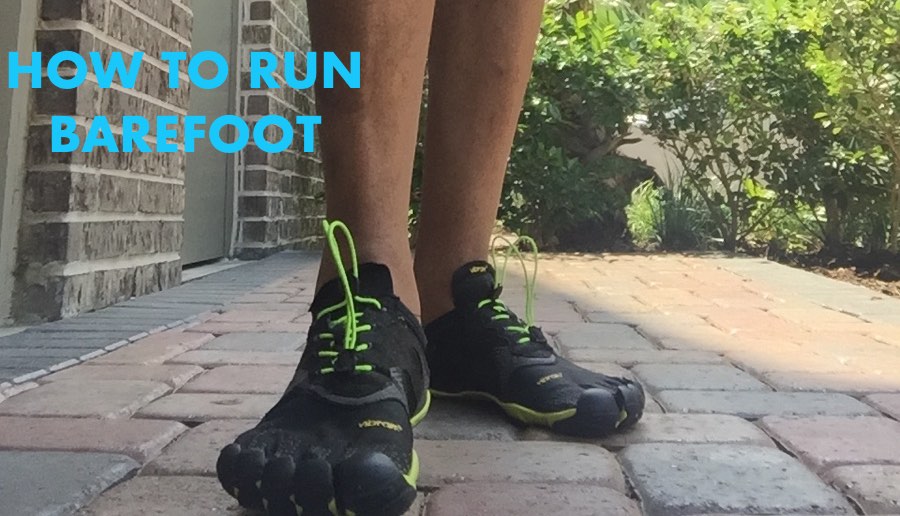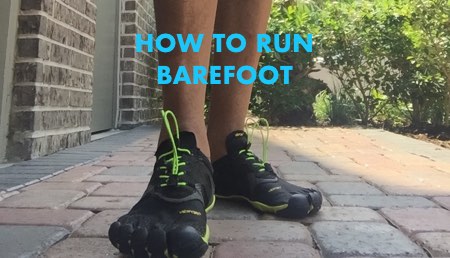
GETTING READY FOR MY RUN IN MY VIBRAM FIVE FINGERS
How To Run Barefoot (Advanced Techniques)
Table of Contents
Now that you have been running barefoot for a while you are probably ready to move on from beginner to learn How To Run Barefoot with Advanced Techniques.
Heres the short answer. As an Aspiring advanced barefoot runner, there are a series of steps we need to consider. For example, we need to refine our stride pattern, work on our pace and cadence some more, eliminate lateral movement, introduce variation to our running routes, and finally run outdoors. From my point of view running on the treadmill doesn’t count.
So let’s run (pun intended) through the steps with as many details as possible.
Run Outdoors
Avoid the treadmill at all costs if you possibly can. Running outside is such an exhilarating feeling that it would be a shame to pass it up whenever you can. Try not to get complacent and run on the treadmill as an alternative. You can choose a variety of terrain from the pavement, to trails, to cross country running to running uphill and downhill to explore your environment.
Run More often
Maybe you are beginning to consider entering a charity 5k, or as part of your Barefoot Running goals, you set to challenge yourself to get better. Then running 2-3 time a week as an advance barefoot runner will not give you the gains you need pre-race or competition.
Now is the time to start thinking about running daily or every weekday with the weekend for recovery. Yes, its a bit more work but the trick here is to vary what you do on the runs. For example 3 days a week you can do timed tempo runs, and twice a week you can do short sprint work and drills.
Invest In Better Running Kit
As an advanced barefoot runner, you are now at the point where it will be worth investing in some good quality running kit. What you get will be weather dependent depending on the season. The necessary approach will be to split what you get into winter and summer roughly and is location dependent. Spring and autumn I guess are for the more fashion aware amongst us.
The goal of the kit is to keep you warm or cool to protect you from the elements as needed during your run.
Price, durability, quality and weight of the kit are also a factor.
The essentials may include (but not limited to):
- FaceCaps
- Lightweight windbreaker or jacket.
- Compression tops (long and short sleeves)
- Compression bottoms (Long and short)
- Running shorts
- Running vest/tops
- Barefoot socks
- Running socks
- Barefoot shoes (You will need more than one pair)
- Waterproof headphones (Bluetooth Or Wired)
- Run Tracking app (to track your time and progress)
Next, we have to consider quantities of the clothing. That will depend on how many times a week you run for example and the wash cycle to keep your kit clean. Hunt online for deals and sales to get the best prices you can and then pick them up as you go.
Brand names range from Skins to 2XU to Helly Hansen. To me, I say go for what is the best quality you can afford and get as many pieces as you can. Thes steps will help to make them last longer as they will not be put through the wash cycle as often as I said earlier.
Join A Group Of Runners
Running Barefoot with others is always a good idea to increase your enjoyment of the activity. It may also be an idea to set up or join a local barefoot running club. Doing so will help you do just that and get the most out of your barefoot experience. You can even form a running club at work to go on a lunchtime run. Doing activities in general with other like-minded people is an excellent way to grow and to encourage other beginners barefoot runners on their journey.
Pace Yourself
Even though you are more experienced now pace yourself so you can keep your heart rate at a level that will allow you to cover your entire distance. For example on a 5K run set your pace on the threshold of your abilities so that you don’t skyrocket your heart rate. It will be difficult to pull back from the pain of it and to stay on track to achieve your times if you do.
Keep To Short Stride Lengths
I cannot overemphasise this enough. Resist the temptation to overextend and overstride on your run. Overextending will waste unnecessary energy that will not be difficult to apply to move you forward. Efficiency on the during the movement will maximise energy output and convert miles will be the difference in your times and distances.
Keep your feet under your torso as you fall forward. Allow gravity to help you positively.
Run Upright
Let’s take a 2 phased approach.
First
Make sure that your shoulders are not rounded and slouching forward. This tends to happen even more as you get tired later on in the run. To remedy this:
- Push your shoulders forward
- Upwards
- Then back to get into the final position
- Relax into that shoulder position
Second
- Get into and remain in the upright position
- With a big chest and head in the upright position
- Eyes looking at the horizon or into the distance
- Make sure that your diaphragm is not squashed
- Breath through your belly
Work Your Arms
Your arms act almost like a secondary propulsion system. Have a look at the running form of Olympic athletes as the right place to start. Usain Bolt comes to mind; there is a frantic but rhythmic generation of additional torque. The Pumping of the Arm plays a crucial role in generating this.
Point Everything Forward
Yes, I know the subtitle sounds a bit strange, but the idea is simple, bear with me while I explain. Typically when you run, there is often a tendency to move sideways, with your head bobbing up and down and so on. Inefficient movement is a colossal burner of energy as any movement that does not work to propelling you forward is a waste of energy. Your lean, gait, arm movement, and cadence should all be pointing and driving you forward.
Track Everything
Track all your progress as soon as you can. this in addition to planning Which I will discuss next will get you all the data points you need to track your progress.
As an old coach of mine used to say –
“Figures don’t lie and liars don’t figure”
Use whatever works for you to track your progress, from the humble pen and paper to an app on your phone or desktop. The beautiful thing is that current tech allows us to get apps that are interactive and let you post your time online if you are so inclined, to challenge yourself.
Have A Training Plan
Having a plan for tracking all your training activity is key to keeping a handle on where you are. Doing this will help to encourage you on your journey. There are many free planning tools available online to help you do this. So have a look and choose what best suits you.
You will have a set of data points to see how effective your training is.
Enjoy the Running
As I always say enjoy the process as much as possible. Pushing to the levels of an advanced barefoot runner is not an easy task. It will suck as you overcome the mental resistance trying to hold you back to training.
Conclusion
I have laid out quite a few tips that all my research has been able to dig up. I know they will be beneficial if you add them to your toolkit if you like in your barefoot running journey.
- Run outdoors
- Run more often
- Invest In Better Running Kit
- Join a group of runners
- Pace Yourself
- Keep To Short Stride Lengths
- Run upright
- Work Your Arms
- Point Everything
- Track Everything
- Have a training plan
- Enjoy the running
Finally, remember to stretch and mobilise after all your running, before and after whichever works best. By now you will have a good idea. My favourite tools are the humble lacrosse ball and foam roller.
So!!! get to it, enjoy the process, embrace the suck and excel
Good luck
